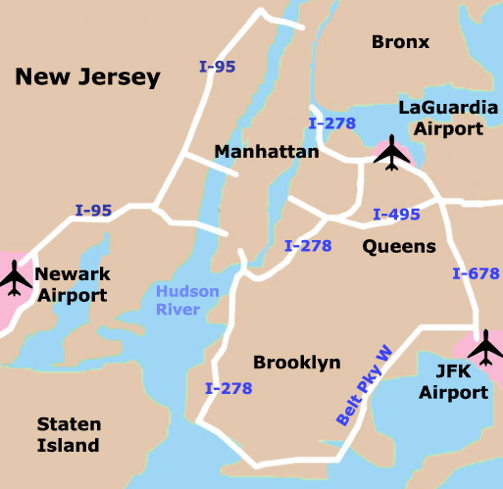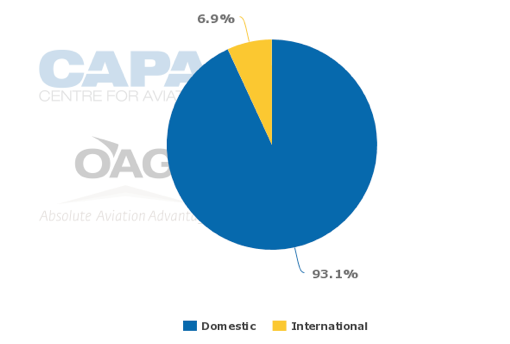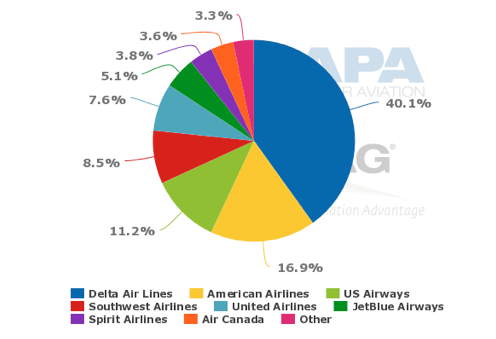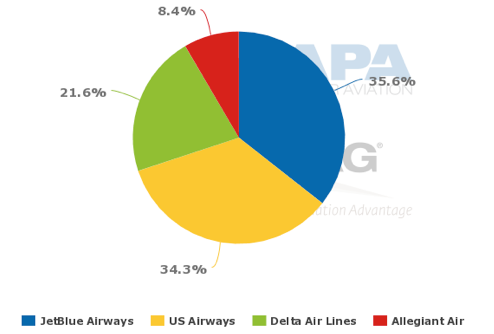New York LaGuardia airport – rehabilitate or close down? Is privatisation a more useful option?
At the beginning of May-2015 the Port Authority of New York and New Jersey (PANYNJ) delayed, again, deciding between two proposals for the close to USD4 billion project to rehabilitate the dilapidated Central Terminal Building at LaGuardia Airport (LGA). Contempt for the state of disrepair, the crowds and the general squalidness at LaGuardia had become so pervasive that Vice President Joseph R. Biden Jr. has likened travelling through LaGuardia to an experience "in a third world country."
LaGuardia is representative of the US' declining aviation infrastructure and is certainly not alone. Many of the US' government and business executives have expressed concern about the state of US airports in general and how, like with the airlines (as they have consolidated and pared costs), they no longer compare in any way to the air transport offer from countries in Asia and the Middle East. But neither is Mr Biden alone.
LGA has been ranked in numerous customer surveys as the worst in the United States. A recent New York Times op-ed article challenged thinking (although without a mention of possible privatisation).
Feelings are strong on the matter. Serious newspapers such as the New York Times are giving space to suggestions from industry experts that LGA should be closed down altogether and air services redirected to other PANYNJ airports.
That outcome is highly unlikely but, while the delays over the Central Terminal continue, such speculation is only to be expected. In the wider context of the US infrastructure debate, the La Guardia case is attracting more than the usual attention.
In the interim it is useful to compare the situation with that of London, the only city airport system to be busier than New York's and which has experienced its own lengthy infrastructure delays.
New York has the world's second largest airport system
The New York airport system is the second largest of any city in the world after London, with 116 million passengers in 2014. The three main airports - J F Kennedy, LaGuardia and Newark Liberty in New Jersey - are mainly O&D airports (in comparison to Atlanta, Chicago O'Hare and Dallas for example, at which the primary activity is hubbing). There is more than enough point-to-point air traffic without New York positioning itself as a hub, which is perhaps a lesson that London could evaluate as the debate on airport capacity there draws to a conclusion.
LaGuardia is situated in the northern part of the borough of Queens and is physically the closest of PANYNJ's three main airports to Manhattan. JFK, the city's principal international airport is in the southern part of the same borough.
At just four miles from northern Manhattan LGA occupies a similar position to London's City airport (six miles from the financial district) and is regarded as the most convenient. It is even accessible by a local bus service from upper Manhattan that connects to multiple subway lines; an inexpensive journey that takes just 30 minutes. (In common with most US airports there is no direct rail link - either heavy intercity or light local).
New York airports locator map

LaGuardia is the busiest airport in the United States not to have any non-stop service to Europe. A perimeter rule prohibits non-stop flights to or from points beyond 1,500 miles (2,400 km), with a small number of exceptions.
Most transcontinental flights use JFK or Newark as do all international flights except those from pre-cleared Canadian airports within the perimeter. There is no border control facility at the airport.
New York LaGuardia Airport international vs. domestic capacity share: 11-May-2015 to 17-May-2015
In that sense another airport it might be compared to is Toronto's downtown Billy Bishop City (or Island) Airport although that is much closer to downtown and also much smaller, at less than three million ppa. The commonality is that Billy Bishop's routes are also limited to the US and Canada (there are occasional services to the Caribbean from LaGuardia).
LGA is a hub for Delta Airlines and also a focus city for American Airlines and its affiliates. American was the airline to take up New York Mayor Fiorello La Guardia's call for a "proper airport" in New York City at the time when Newark, across the Hudson River in New Jersey, was acting as New York's primary airport; American acquiring some valuable real estate as part of the deal.
Delta and American/US Airways currently account for over 68% of seat capacity per week at LGA.
New York LaGuardia Airport capacity seats per week (all carriers): 11-May-2015 to 17-May-2015
So LGA would appear to have much going for it, were it not for the run-down state it has gotten into. The site of the airport was originally an amusement park, but no-one is laughing now.
LGA has been described as America's 'worst airport'
In an article in the Los Angeles Times in Jan-2014 LGA was described as a 'terminal case' and 'America's worst airport.' The bus service that was mentioned previously was described as 'standing room only' as it bounced through Manhattan and Queens. That is hardly the fault of the airport - but when the ball starts rolling....
Aerotropolis guru John D Kasarda weighed in with his own take, describing LGA as dingy and noting how he had offered condolences to a caller who was phoning from LGA, "and not entirely in jest."
As long ago as 2010 a previous Port Authority CEO had suggested LaGuardia be torn down. And yet it is difficult to know exactly where to point the finger.
LaGuardia has four interconnected terminals. As with the other PANYNJ airports, some terminals are managed and maintained by airlines themselves. Terminals C and D and most of Terminal A are operated by Delta Air Lines, with Terminal B under direct PANYNJ operation. As is often the case at major US airports the airlines themselves refurbish their own terminals. Indeed, in 2012, Delta launched the largest expansion at LGA in over 40 years, investing more than USD160 million to expand and update Terminals C and D.
Shortly afterwards the PANYNJ issued a statement to the effect that LGA would commence a USD3.6 billion upgrade programme "over the next six to 10 years." At that time around 25.7 million passengers per annum were using LGA and that was expected to increase to around 35 million by 2030. LGA is on track with that growth estimate though it slowed in 2014 in which year the total was 27 million. In 2013 it was 26.7 million.
New York LaGuardia Airport annual passenger numbers
This upgrade programme has embraced many projects including a USD255 million infrastructure modernisation project; an additional 3,000 space garage; and a major storm mitigation and resiliency project to protect vital infrastructure against future flooding. But the icing on the cake is the new Central Terminal Building (CTB) project, which itself has since been costed at USD3.6 billion.
A public-private partnership was envisioned for creating the CTB, with private funding covering the estimated USD2.5 billion cost of the new terminal, and the Port Authority covering approximately USD1.1 billion in related infrastructure improvements, including the new west garage mentioned above.
Bidders for the CTB project were eventually whittled down to:
1. LaGuardia Gateway Partners
An alliance of construction companies, architects, operators and financiers. The consortium comprises of Skanska, Walsh Construction, Vantage Airport Group (Canada) Meridiam, Morgan Stanley, Citigroup, Wells Fargo and Parsons Brinckerhoff.
2. LGC Central Terminal Consortium
A joint venture of Tutor Perini, Aéroports de Paris (AdP), TAV Construction, Goldman Sachs, Suffolk Construction, STV, Arup and Kohn Pedersen Fox.
Of the other bidders the LGAAlliance was a consortium of construction companies, architects and financiers comprising of Australia's Lend Lease Corporation, Construction LMB Inc., Turner Construction Co., Gensler Architecture, Design & Planning P.C., Macquarie Capital Group Ltd., and Hochtief AirPort GmbH (q.v.). The bid was not successful at the shortlist stage.
Aerostar Holdings, operator of the US' only privatised major airport in Puerto Rico, was excluded from bidding in Mar-2014.
Governor Cuomo's intervention has confused the picture
It has been a protracted procedure and especially so because of the intervention of New York State Governor Andrew Cuomo from the beginning of 2014. Governor Cuomo eventually decided to appoint a separate and independent competition to make broader design recommendations on the LGA upgrade towards the end of 2014, focusing on the CTB there and also with a brief to make other design improvement suggestions at LGA and other airports.
Naturally there have been concerns as to whether it will be possible to reconcile the existing terminal redevelopment, which the Port Authority and the bidders have already spent two years working on, with the design competition's recommendations for the facility and its surroundings, and especially within a short time frame. The bids for the design competition are currently being evaluated. In the interim the two remaining bidders were told - twice - to extend their bids, and on the second occasion through to 11-May-2015. The final bid selection was initially to have taken place in 1Q2015. A decision may now be made at a Board meeting on 28-May-2015.
While this all drags on there remains the possibility that the bidders, which have already baulked at the delay, will withdraw their interest altogether, and in any case it is considered unlikely the bids will be extended beyond May. The bidders believe further delays would eat into their profits because construction costs are rising as the real estate market reaches new highs, sharply pushing up the price of labour and materials.
It is particularly likely to be so in the case of LGC Central Terminal as AdP and TAV were drawn together to bid for this project while both have at least equally big fish to fry elsewhere. After the disaster of both of the Chicago Midway Airport lease transactions PPPs such as this were thought to be the way forward for the private sector to offer much needed support in the renovation of America's creaking airports. Political meddling again might see the end to that.
Now it remains to be seen if the recommendations of the Governor's advisory committee can be reconciled with the existing bids.
The design panel commissioned by Governor Cuomo recommended sweeping changes at LaGuardia including the creation of a 'great hall' in the central terminal building that would serve as the main entrance to travellers. The panel also recommended creating seamless connections between terminals, adding a new air train station and building a hotel on airport grounds. The panel also recommended creating a cell phone waiting area for people who are retrieving passengers from the airport. High-speed ferries could also be part of the deal.
The planned construction project will see the three-level, 1.3 million sq ft terminal be expanded to be one-third larger than what it currently is. The seven-year project will not increase the number of gates, however will spread the 35 gates out, in order to accommodate for larger aircraft. The project will also create additional F&B and retail space and parking space.
But what of the 'close it down' scenario that was mentioned in the headline?
Big expenditure on infrastructure won't solve LaGuardia's problems
That arose out of an op-ed (external opinion) piece in the New York Times on 08-May-2015, which was accompanied by a cartoon of 'flying bulldozers' zero-ing in on the terminal building. Some of the text is repeated here, in quotation marks.
In it the correspondent, a civil engineer and transportation planner, (and a responding correspondent), said piling billions of taxpayer dollars into upgrading LaGuardia, which opened in 1939, won't solve its fundamental problems. "It can't easily expand. LGA's two runways and four terminals are surrounded on three sides by water, making landing difficult and hazardous. Parking is a nightmare."
Moreover, "some 50,000 people who live near LaGuardia are subjected to a level of noise higher than the standard deemed acceptable by the FAA, according to a 2011 study by the Regional Plan Association. (Another 95,000 living near Kennedy International Airport, also in Queens, and 44,000 living near Newark Liberty International Airport, are affected as well.)"
"The popularity of LaGuardia is almost entirely related to proximity - a typical nine-mile trip to Midtown Manhattan can be done in about 20 minutes during off-peak hours, 10 to 30 minutes less than it would take to get to Kennedy or Newark. But proximity comes with a price."
"With the consolidation of the major United States airlines and the sluggishness in the global economy, the much larger Kennedy and Newark airports could accommodate LaGuardia's passenger load, by adding more frequent service and using larger aircraft, if the FAA were to lift the caps on the number of flights allowed there. Kennedy, with its two sets of parallel runways, could handle many more flights, particularly as new air-traffic control technology is introduced in the next few years."
"Most flights serving LaGuardia already duplicate flights that serve Kennedy and Newark. Many of these flights are to a relatively small number of regional hubs. Average loads per flight at LaGuardia are only two-thirds those at Kennedy. Small regional jets, with fewer than 100 seats per plane, make up a little more than half of LaGuardia's peak-period flights. Airline efficiency would be improved by concentrating traffic on fewer, larger aircraft, while still maintaining service to major hubs."
LGA development - or not - should be part of a coordinated aviation plan
"The Port Authority, which operates all three major airports, is conducting noise studies, at the request of Governor Cuomo. New York Mayor Bill de Blasio should insist that the LaGuardia (expansion) study examine the feasibility of closing the airport, and that plans for a new terminal be put on hold until the study is completed."
"That study should take place in the context of a comprehensive aviation plan for the region, which would examine, among other things: trends in the growth in air travel; the environmental consequences of applying advanced air-traffic-control technology; modernising runway and terminal layouts and improving rail access at Newark; and finding an appropriate role for secondary airports like Stewart (Newburgh), Westchester and MacArthur, which currently handle a tiny fraction of the region's air passengers."
"Stewart Airport, over 60 miles north of Midtown, in Orange County, N.Y., has significant room for expansion and can accommodate long overseas flights (CAPA comment: one runway is 3.6 km), and strong support exists for an enhanced rail connection to MacArthur, in the town of Islip, on Long Island."
Stewart International Airport Network Summary (at 18-May-2015)
|
4 |
|
|---|---|
|
Domestic only |
4 |
|
International |
0 |
|
Total non-stop passenger destinations |
5 |
|
Domestic |
5 |
|
0 |
|
|
0 |
|
|
0 |
|
|
0 |
|
|
0 |
|
|
0 |
|
|
Total non-stop freight destinations |
0 |
|
Domestic |
0 |
|
0 |
|
|
0 |
|
|
0 |
|
|
0 |
|
|
0 |
|
|
0 |
Stewart International Airport capacity (seats per week, system): 18-May-2015 to 24-May-2015
(Coincidentally, PANYNJ said on 14-May that it is considering reclassifying Stewart International Airport as a New York airport and modifying its name to reflect better its location and better compete with other major airports. Stewart could be anchored on 'New York', 'Downstate New York' or some variation on that in an attempt to attract people outside the geographical region of the Hudson Valley. PANYNJ also operates Atlantic City airport in New Jersey but it does not come in to the reckoning in the quoted op-ed piece).
The article continued, "The money budgeted for the LaGuardia upgrades could be better used to create a long-proposed one-ride express-rail link between Manhattan and JFK, by reviving a long-disused, 3.5-mile stretch of track in central Queens and completing the modernisation of the terminals at Kennedy. Currently, passengers who use the AirTrain to reach JFK must transfer from subways or the Long Island Rail Road. A world-class, direct rail trip to Kennedy could match the current travel time of even a fast, off-peak car trip to LaGuardia."
Finally, the correspondent says, "think of what the 680 acres of city-owned land on which LaGuardia sits could be used for. If built at the density of a typical housing complex it could accommodate over 30,000 homes. Even more could be built in nearby areas, where growth is currently restricted because of LaGuardia's flight paths. This would contribute significantly toward Mayor de Blasio's plan to develop 200,000 units of affordable housing."
"By avoiding the costly replacement of outmoded terminals at LaGuardia and by creating a new express rail link and upgrading terminals at Kennedy, the increased economic activity could more than make up for the lost jobs (not to mention the jobs that would be created by redeveloping the LaGuardia site)."
"There are precedents for replacing airports close to the centre city with modern, more outlying airports. Hong Kong and Denver are two examples; Berlin will soon follow suit."
"New York's importance to America's economy demands a first world vision to shutter this third world airport."
Is it seriously realistic to talk of closing down an airport - let alone one with 30 million pax?
What are we to make of this bold suggestion to close down a growing airport that handles close to 30 million ppa?
Firstly, a technical oversight: The Brandenburg International Airport (BBI) at Berlin is being built very close to the site of the existing Schoenefeld Airport. Tegel Airport is expected to close as Templehof airport already has. BBI is further out than both Tegel and Templehof but is not being built purposefully further out than Schoenefeld. Sometimes in the US non-US airport developments are reported outside a proper context.
Hong Kong Kai Tak airport was closed down at least partly owing to the proximity of buildings on the approach path.
It could even be argued that the trend is towards favouring airports close to city centres such as London City (which London's Mayor Boris Johnson, Bill de Basio's equivalent, seems to be keen on restricting, for his own ends), Toronto Billy Bishop and even Stockholm Bromma, in support of which there is a growing movement. There is little prospect of closing Sydney's existing near-downtown airport if and when a new, bigger airport is built at a more remote site. Reykjavik's downtown/city domestic airport serves a specific purpose, delivering remotely located farmers and businessmen directly to where they want to be; the city's nearby financial centre, thus facilitating one day round trip visits. The main international airport at Keflavik is one hour distant.
Comparing New York and London airport systems
Setting that apart, there are some interesting comparisons with the situation in London, one that might be resolved soon (or might not). Reference is made again here to the op-ed text, in quotes:
"It can't easily expand. Its two runways and four terminals are surrounded on three sides by water, making landing difficult and hazardous."
While there is no water restriction at the London airports (except City), the airport regarded as London's third, Stansted, would also have problems expanding by way of adding one or more runways because of the proximity of a nearby town.
The fourth airport serving the capital by size, Luton, managed to get an expansion programme to 18 million ppa approved but only with great difficulty. It is hemmed in by urban structures and is contained within a small area close to the downtown zone;
"Moreover, some 50,000 people who live near LaGuardia are subjected to a level of noise higher than the standard deemed acceptable by the FAA."
Bearing in mind that almost twice that number are affected at JFK on the correspondent's own admission - an airport he would like to see expanded - the argument does not seem to stand up to scrutiny;
"With the consolidation of the major United States airlines and the sluggishness in the global economy, the much larger Kennedy and Newark airports could accommodate LaGuardia's passenger load, by adding more frequent service and using larger aircraft."
Not much was said here about the need for infrastructure enhancements at those airports. Economic sluggishness in the US appears to have bottomed out;
"Most flights serving LaGuardia already duplicate flights that serve Kennedy and Newark. Many of these flights are to a relatively small number of regional hubs. Average loads per flight at LaGuardia are only two-thirds those at Kennedy. Small regional jets, with fewer than 100 seats per plane, make up a little more than half of LaGuardia's peak-period flights. Airline efficiency would be improved by concentrating traffic on fewer, larger aircraft, while still maintaining service to major hubs."
That is a fair point but the minor hubs and their spokes could be cut off from New York;
"…finding an appropriate role for secondary airports like Stewart (Newburgh), Westchester and MacArthur…"
It has been shown over the years that these small airports have their own small catchment area and that users of the main metropolitan airports are often reluctant to use them;
"The money budgeted for the LaGuardia upgrades would be better used to create a long-proposed one-ride express-rail link between Manhattan and JFK, by reviving a long-disused, 3.5-mile stretch of track in central Queens and completing the modernisation of the terminals at Kennedy. Currently, passengers who use the AirTrain to reach JFK must transfer from subways or the Long Island Rail Road. A world-class, direct rail trip to Kennedy could match the current travel time of even a fast, off-peak car trip to LaGuardia."
US airports and their cities are close to unique in their ability to shy away from direct air-rail links, often preferring to compromise by operating a bus from the closest main line station and making do with that. New York is no exception. There is no comparison with London where three of the top four airports have their own rail connection, the fourth's terminal is ten minutes from the rail platform and the smaller fifth and sixth are also connected by either light rail, underground metro or heavy rail.
Although Heathrow Airport will not be connected to the proposed HS2 high-speed line it already is connected to the outskirts of the downtown area by a non-stop service and will be connected directly into and through it within 2-3 years. Disused lines are being brought back into service to enable passengers from the west to be able to travel into Heathrow. Furthermore many airports have intermodal facilities. New York has a lot to learn from London in this sense.
Finally, the correspondent says, "think of what the 680 acres of city-owned land on which LaGuardia sits could be used for. If built at the density of a typical housing complex it could accommodate over 30,000 homes. Even more could be built in nearby areas, where growth is currently restricted because of LaGuardia's flight paths. This would contribute significantly toward Mayor de Blasio's plan to develop 200,000 units of affordable housing."
While there is no plan in the UK to close down an airport for the same reasons advanced by these correspondents in New York, it is the case that the Mayor of London, Boris Johnson, did propose closing down Heathrow Airport and the provision in its place of housing for 60,000, as a quid pro quo for developing his 'Thames Estuary airport.' Mr Johnson is now also MP for Uxbridge, a suburb close to Heathrow and where many of the 75,000 directly and indirectly employed workers at and around Heathrow live! So it is possible that the New York advocates for closing LaGuardia took their cue from events in London.
But the real point is; would an airport ever really be closed in London? Even in the ultimate Boris Johnson nightmare scenario Heathrow continues as a local airport servicing West London as London City does for the new financial City in the east. Notably, all are privately owned and operated by a variety of private sector interests that are based both within and outside the UK. It is a scenario about as far removed from the Congress blessed state joint venture between New York and New Jersey that controls the JFK, Newark and LaGuardia airports, even if various sorts of privatisation have been proposed for those airports in the past.
London airports and their privatisation could be a role model for New York's infrastructure needs
In summary, public outrage such as this in New York arises from longstanding inertia where airport infrastructure is concerned. That outrage, stirred up here by the delay in the decision over the LaGuardia terminal, is easily and even appropriately manifested locally where there are powerful - and national/global - media outlets such as the New York Times.
But the inertia is a nationwide malaise and would not be so easily manifested in (strictly for example) Chattanooga, Tennessee or Boise, Idaho. London, the only city airport system that has more passengers travelling through it than New York has its own inertia issues, as CAPA has consistently reported. But while a decision there on a single extra runway is still awaited is it perhaps the case that New York can learn from London in two respects:
(1) The value of privatising the main airports and ensuring they compete with each other. This ideal scenario has delivered far superior infrastructure at Heathrow and Gatwick airports, now at Stansted, and to a lesser degree at Luton, City and Southend airports. (All of these airports are separately owned and managed with the exception of one commonality, namely Global Infrastructure Partners at Gatwick and City though in each case there are other separate shareholders as well - including US ones!);
(2) The co-ordinated provision of surface transport connections, enhancing access, egress and connections to, from and between those airports. In the case of New York and New Jersey one organisation (PANYNJ) has much of the responsibility for this but it is way behind London where that responsibility is, conversely, shared between many different stakeholders.
See related report: The US airport system is lagging badly, but there is still little appetite for private investment (Apr-2015).



